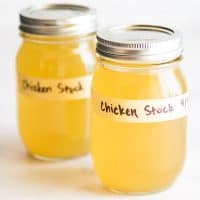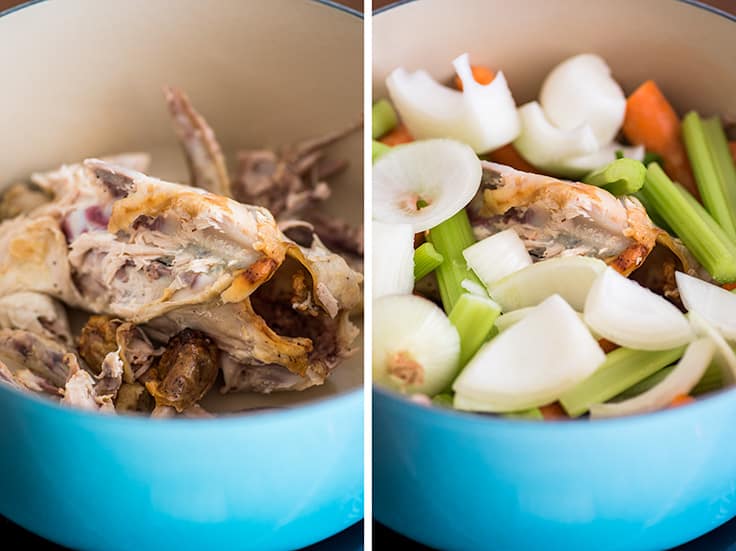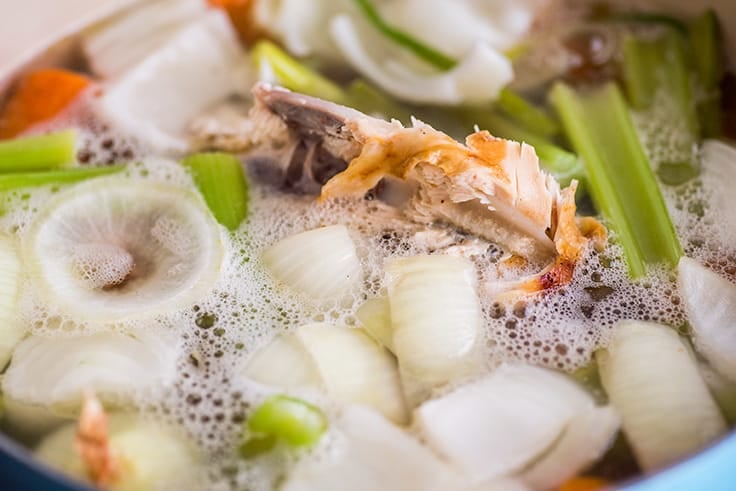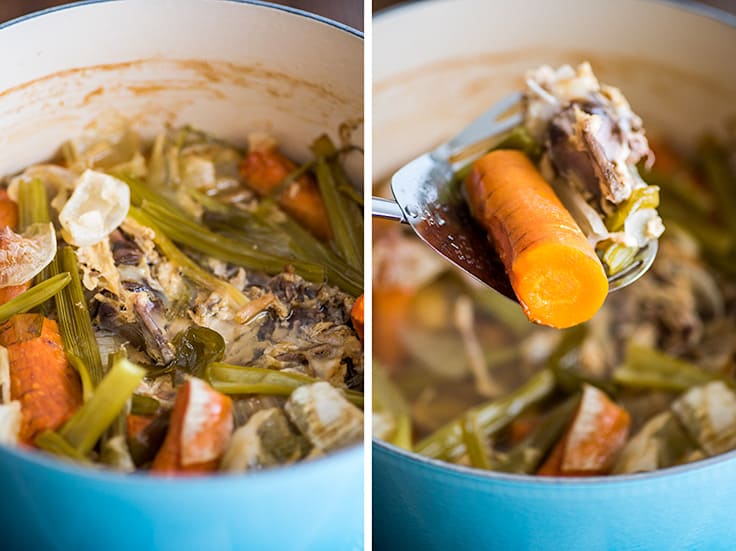How to make chicken stock: your complete guide to making an easy, rich, and delicious chicken stock at home.
A while back I posted an epic guide to making Roasted Chicken (which you should definitely go read if you haven’t already!). And as a follow-up, I have another guide for you: How to make chicken stock (from the leftover chicken carcass).
If you’ve never made homemade chicken stock before, friend, you are in for such a treat.

Why You Should Make Chicken Stock at Home
There’s a richness and depth of flavor to homemade chicken stock that you just can’t get from stock that comes from a box. The store-bought stuff is perfectly fine and serviceable; I use it all the time. But when you taste something made with homemade stock, oh man, can you taste the difference.
The good news is that while making homemade chicken stock is definitely a time commitment–it needs about 4 hours of simmering time–it’s not tough to make or labor-intensive.
You can let it simmer on a lazy Sunday so your house smells like a holiday while you watch Netflix, or throw it on the stove in the morning while you’re deep cleaning the house and feel doubly productive when you’re loading freshly made stock into your fridge around mid-afternoon.
What You Need to Make Chicken Stock
- Roasted chicken carcass: (Turkey will also do.) If using the carcass of a smaller (less than 3 pounds) chicken, like a small store-bought rotisserie chicken, you might want to use two to make sure your stock has enough flavor.
- Vegetables: You want flavorful but neutral veggies that are going to complement the chicken flavor and not clash with anything you might use the stock in later. Carrots, celery, and onion are the most common stock veggies, but some people also use things like leeks, garlic, and parsnips.
Veggie Notes: I threw some green onions in this batch of stock because they were about to go bad in my crisper and I only had half a yellow onion.
You don’t need to be too precise with your measurements. But, if you’re not sure where to start, three large carrots, three celery ribs, and one whole onion can do no wrong.
- Filtered water: You don’t have to use filtered water, but if you don’t drink tap water because you don’t like the taste, don’t use it in your stock.
- Vinegar: Vinegar, white or apple cider, is optional, but it helps break down the bones for a richer and luxurious stock. You might smell the vinegar for the first hour or two of cooking (if you really try), but don’t worry, it will not make your stock taste vinegary.
- Fine-mesh strainer: A fine-mesh strainer will strain out all the little vegetable and bone bits. You can use the strainer alone, or for perfectly strained stock, use it with cheesecloth.
- Cheesecloth: Cheesecloth will make sure *all* solid bits are filtered out of your stock. You can find cheesecloth at most grocery stores, usually in the baking aisle or order it cheap online.
Making Chicken Stock With Frozen Vegetables and Chicken Carcass
I almost always make my chicken stock with frozen ingredients. It’s a great way to reduce kitchen waste and means you can make the stock when you feel like it, not just when you have a chicken freshly roasted.
I freeze chicken carcasses immediately after they’ve been picked clean and keep a separate zip top bag in the freezer for spare vegetable ends and pieces. Any time I cut the top off an onion or stalk of celery, cut too many carrots, or have some veggies that look like they’re on their last leg, I scrub them, chop them, and toss them in the bag.
I know it’s time to make stock when a gallon bag’s about half full and has about equal amounts of celery and carrots with some onion in there.
You’ll use the frozen ingredients exactly the same way as fresh, they’ll just take longer to bring up to a simmer.
How to Make Chicken Stock
1. In a large Dutch oven, combine chicken carcass and vegetables.
2. Add 8 to 12 cups of water, enough to mostly cover the carcass and vegetables. Then pour in a tablespoon of apple cider or white vinegar to help break down the bones.
3. Bring the stock to just barely a simmer. It’s hard to show in photos, but you don’t want a rolling boil, just small bubbles rising to the surface. A continuous boil can make your stock cloudy, which doesn’t hurt anything, but doesn’t look quite as pretty.
Cook for 3 to 4 hours, skimming fat off the surface occasionally, and checking to make sure the stock has not come to a boil.
4. Once the stock has simmered, and reduced by one-half to two-thirds, use a slotted spoon to remove and discard the vegetables and bones.
5. Strain the chicken stock through a fine-mesh strainer and (optionally) a couple layers of cheesecloth folded together. Transfer it to mason jars and store in the refrigerator for up to 4 days.
The stock will become gelatinous when chilled (it will set and jiggle), and any fat will rise to the top. Scrape the fat layer off before using, and 30 seconds to a minute in the microwave will return the stock to its liquid state.
Using Homemade Chicken Stock
Chicken Stock can be used in any recipe that calls for chicken broth or stock. When using homemade chicken stock in recipes that call for broth, use half chicken stock and half water (if a recipe calls for 8 cups of chicken broth, use 4 cups stock and 4 cups water). You want to dilute the stock because it’s very rich and adds a ton of flavor, which can sometimes overpower clear soups.
The one thing to remember when making things with homemade stock is ALWAYS ADD SALT. Store-bought stocks and broths are usually quite salty, so don’t be alarmed if you find yourself adding a lot of salt to compensate.
My favorite recipes to use with homemade stock are:
- Ham and Potato Soup
- Creamy Chicken Noodle Soup
- Quick Chicken Tortellini Soup
- Creamed Turkey
- Peasant Soup
- Ground Turkey Vegetable Soup
FAQ
How much stock will this make?
This should make about 4 cups/1 quart of very rich and flavorful chicken stock. If a ton of the liquid has evaporated and you are left with a more concentrated stock that is less than 4 cups, simply add water back until you reach 4 cups.
If you plan on using the chicken stock in recipes calling for chicken broth, dilute the stock using 1 cup of water to 1 cup of stock so you will get 8 cups/2 quarts of less concentrated stock that is *so good* in soups.
Can I freeze chicken stock?
Absolutely. You can freeze chicken stock for up to 3 months. If freezing in glass jars, be sure to leave plenty of headspace at the top so when the stock expands as it freezes it doesn’t crack the jar.
For more on my favorite freezing tips and tricks, go check out my post, How to Freeze Soup.
What’s the difference between chicken stock and broth?
This is really simple. Stock is water simmered with bones. Good stock will jiggle when chilled due to the collagen released from the bones and have a rich flavor and mouthfeel.
Broth is water simmered with meat (and sometimes bones) for a shorter period of time. It’s faster to make, less rich, and is usually seasoned while cooking.
They can be used mostly interchangeably, but you might miss some flavor and richness when using broth for a recipe calling for stock, and homemade stock should usually be thinned with water when using in recipes calling for broth.
For more How To Tutorials, you might also enjoy:
- How to Cook Chicken Breast for Salads and Sandwiches
- How to Cook Shredded Chicken
- How to Cook Chicken for Recipes

How to Make Chicken Stock
Ingredients
Special Equipment
- Fine-mesh strainer
- Cheesecloth optional
Homemade Chicken Stock
- 1 chicken carcass picked mostly clean of meat
- 3 large carrots peeled and cut into large chunks
- 3 large celery ribs cut into large chunks
- 1 large onion cut into large chunks
- 8 to 12 cups filtered water
- 1 tablespoon white or apple cider vinegar optional
Instructions
- In a large Dutch oven, combine chicken carcass and vegetables.
- Add 8 to 12 cups of water, enough to mostly cover the bones and vegetables. Add vinegar.
- Over medium-high heat, bring the stock to a simmer. Once the stock begins to simmer, turn heat down to keep it just barely simmering.
- Cook for 3 to 4 hours, skimming fat off the surface occasionally, and checking to make sure the stock has not come to a boil.
- Once the stock has simmered, and reduced by one-half to two-thirds, use a slotted spoon to remove and discard the vegetables and bones.
- Strain the stock through a fine-mesh strainer and a couple layers of cheesecloth folded together.
- Transfer the stock to mason jars, leaving plenty of headspace for expansion if freezing, and store in the refrigerator for up to 4 days or the freezer for 2 to 3 months.
Notes
This post may contain affiliate links, which means I receive a small commission if you make a purchase using them. There is absolutely no additional cost to you.











Linda says
Have been making my own stock for years but did not know about the vinegar. Can’t wait to make that addition. I just go to the local meat market and buy a bag of frozen chicken backs. Usually about three dollars and if I’m being a nice fur mommy, before I throw the spent bones out, I will pick the chicken off for my little dog. I’m just one person so I don’t usually buy a whole chicken so the bones work well for me. Also I like to roast them in the oven before I put them in a pan to start my stock. I keep a bag of carrots celery onion etc. in the freezer too just for my stock. Love your recipes and I cannot wait to try the easy Hungarian goulash that came with this blog today. Sounds yummy!
Pat says
My husband and I disagree on this. I say if you start off with 8 cups of water and cook the stock down to 4 cups the broth will be more flavorful. He says to use 6 cups. And if you end up with 2 cups of broth add 2 cups of water to make 4 the broth will taste the same. Who is correct.
Tracy says
Hi Pat, I hope this was a friendly argument! lol I’d say go with 8 cups just because for most pots 6 cups won’t be enough to mostly submerge the bones and veggies. Whatever is sticking out of the water isn’t adding much flavor to the stock, so there’s no point in only having a pot half full of water and then adding more back at the end.
Pamela Johnson says
Can I use ziplock bags to freeze the chicken stock?
Tracy says
You can. Just when you go to defrost it, set the bag in a clean bowl in the refrigerator just in case the plastic has been nicked or torn so you don’t end up with chicken stock all over your fridge.
Jeni White says
Thank you! I’ve been doing this; we’re on a fixed income, so I was glad to be frugal, and also know what was going in to my stock. Turns out I’ve not been boiling it long enough! I’m also glad to get the vinegar suggestions. Happy Sunday!
Tracy says
Yes! I love making stock for exactly those reasons. I hope you enjoy it!